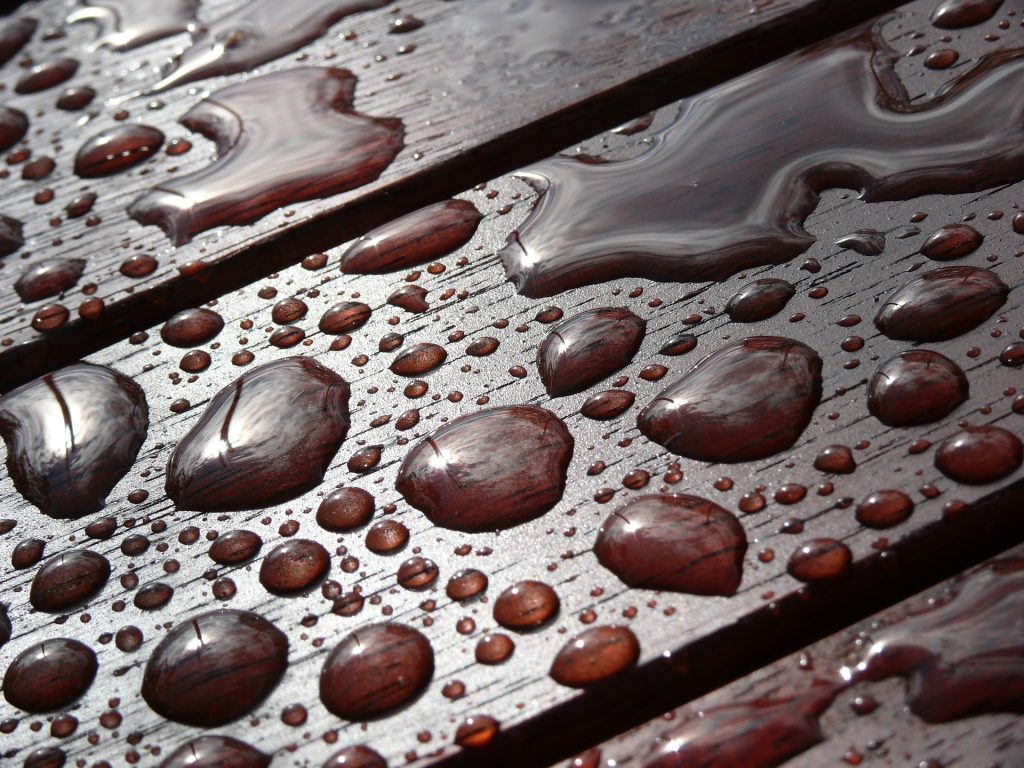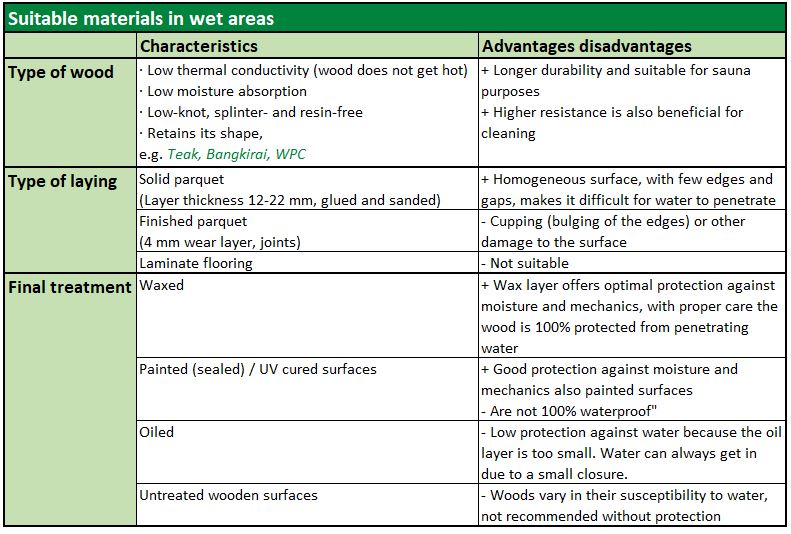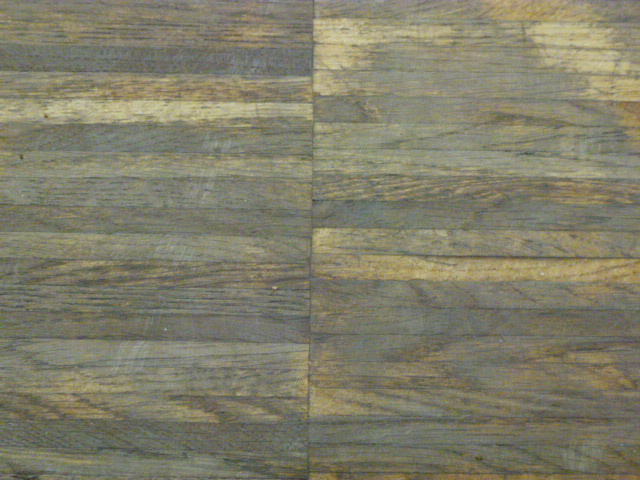Cleaning and maintenance of wooden floorings in wellness and spa areas
Going to the wellness area is something particularly relaxing during the cold season. Guests not only treat themselves to a well-deserved period of relaxation in a cozy ambience in or by the pool, but they also strengthen their immune system in the sauna, for example. Naturally, expectations of hygiene are high. But how can wooden floorings in wet areas be cleaned and maintained without damaging the material and sacrificing perfect hygiene?

Proper cleaning of the wood is essential for the preservation of the material. © Pixabay
The challenge lies in the fact that all wood floorings have a limited resistance to standing moisture. This sensitivity is extremely pronounced in some woods, while other woods react only moderately to contact with water. With the high entry of water in wet areas, surface damage can occur, despite optimal cleaning and care.
The choice of material is crucial
Wood is a popular renewable material in the wellness area, which, in addition to a cozy appearance, also spreads foot warmth and a pleasant barefoot feeling. It is not only used in sauna facilities, but also as flooring. In order to maintain its longevity, various influencing factors must be taken into account.
The most commonly used is teak or bangkirai. The final treatment with oil, which is unfortunately being used more and more frequently, does not offer enough protection for long-term value retention. Damage to wooden floorings in wet rooms can be avoided if possible causes are taken into account when selecting materials. There are woods that can easily absorb moisture. However, even with such types of wood, superficial changes in color and structure are to be expected, which often become noticeable as rough, gray areas (mold spots). Various cleaning methods, agents and frequency must be coordinated depending on the material, type of installation and final treatment. Anyone who is renovating or building a new building should select suitable materials for use in wet rooms (see information box). The floor should be protected early on, ideally before the wet area is put into operation, with a care dispersion (see expert tip) to make cleaning and maintaining its value easier.

© Tana-Chemie
Cleaning wooden surfaces
It is often sufficient to clean wooden floorings dry with appropriate dust-binding products. Wet cleaning is necessary to remove adhering dirt. It is important to take care that little water enters the surface. Standing moisture should remain under no circumstances. Wet cleaning can cause damage to the wood flooring, despite professional execution. Wood is a natural product and therefore does not have homogeneous properties like e.g. elastic coverings made of PVC or rubber. As a result, it is always possible that punctual changes occur on the surface of the wood flooring in wet areas. Woods that are considered waterproof and have an intact surface coating are most suitable here.
Cleaning of painted wooden flooring in wet areas
Even with the most suitable type of wood with (intact) painted surfaces, it must be remembered that they are not 100% waterproof. Wood works – especially in environments with changing humidity and temperatures. In humid environments, wood surfaces absorb moisture and swell, then in dry conditions they release this moisture and shrink. This causes the surface to be repeatedly stretched and compressed, and this causes a coating that is actually impermeable to water to develop fine cracks and crevices, through which water can then penetrate the covering. This effect is intensified by the use of aqueous surfactant solutions (cleaning agents, washing and shower creams, etc.), which have the effect of improving the capillarity of water and the water then penetrates into these finest cracks and crevices. Moisture then spreads in the wood and destroys the surrounding wood. Such damage becomes visible as so-called mildew stains (gray discoloration of the wood fibers). If mildew stains are left untreated for a long time, they can no longer be removed, despite extensive sanding. In this case, the only option is often to replace the affected areas. Nevertheless, lacquering offers good protection against penetrating moisture. It is recommended that lacquered wood surfaces should also be treated again with a care dispersion, thus improving the service life and durability

Mildew stains are a common type of damage to wood in wet areas. To counteract these, treatment with a protective care product such as Timber lamitan is recommended. © Tana-Chemie GmbH
Cleaning waxed wooden flooring in wet areas
Waxed wood flooring is largely water resistant. A well-waxed wooden flooring has the highest water resistance in the short term. However, incoming moisture and dirt often cause damage to the surface, which turns white. With appropriate measures (polishing, cleaning), the floor can be restored to perfect condition. Wax surfaces are particularly susceptible to surfactants and alkaline agents. These gradually wear away the care film layer or cause emulsification of the wax. Therefore, cleaning with surfactant-free cleaners (Tanet karacho) is recommended.
A major disadvantage of waxed surfaces, however, is that they can become slippery over time and then require basic cleaning with solvent-based cleaners (usually based on petroleum ether). This always leads to enormous odor nuisances, which are only reluctantly accepted in wellness or spa areas. Water-based emulsion waxes are not suitable for wet areas due to the emulsifiers they contain, as even a small amount of water causes them to re-emulsify, which leads to rapid destruction of the care film layer.
Cleaning oiled wooden flooring in wet areas
A particularly popular type of surface treatment today is oiling wooden floors. For this, drying oils are used, which leave a relatively thin layer of care film. Oiled floors require the most maintenance. Depending on the load, oiled coverings should be re-oiled up to once a week according to the manufacturer’s instructions. Since this involves enormous effort each time, practice usually looks different. If a floor is newly oiled, the room must be cleared out and the covering must be thoroughly cleaned. After application, the care film must dry for up to 24 hours, depending on the care product used. The surface may not be walked on during this time. Added to this is the high contamination of the room air with solvents. In order not to have to go to this great expense, oiled floors are often just cleaned (e.g. with an all-purpose cleaner), which in the long term leads to a graying of the surface. The better solution is cleaning with a surfactant-free cleaner or cleaning and care, for which a soap-based cleaner should then be used. Regular use of a soap cleaner extends the time until the next oiling.
When disinfection of the wooden floor is necessary
Wooden floorings installed in bathing areas are not suitable for disinfectant cleaning. This applies to all wooden coverings, although lacquered coverings “cope” with this better than waxed or oiled ones. However, all public pools, including wellness or spa areas with attached bathing areas, are subject to the instructions of the health authorities. They can request that in order to achieve sufficient hygiene, all areas walked on barefoot must be disinfected.
In order to achieve sufficient surface disinfection, it is necessary that the agent used remains on the surface for a certain period of time (5, 15, 30, 60 minutes exposure time in accordance with the Biocide Product Directive) and dries off automatically. The area may not be used until it has dried. To achieve sufficient effectiveness, the entire area to be treated must be wetted with disinfectant cleaner and allowed to dry independently. Rubbing dry after disinfection is not permitted. This often results in damage to the wood due to the standing moisture and the biocides used. In addition, the means used must meet special requirements. These should e.g. be effective against human papilloma viruses (abbreviated HPV) to prevent the transmission of wart viruses. Products based on oxygen releasers (e.g. Apesin AP 100 plus) are particularly suitable, as they do not leave any strong residue on the wood surface. However, if used over a long period of time, these lead to a brightening of the wooden surface, as this type of product always has a bleaching effect.
Expert tip
1. Cleaning and maintenance begins after laying
To ensure optimal preservation of a wooden flooring, it is necessary to carry out a combination of cleaning and care activities right from the start. This begins immediately after installation. Wet areas should be provided with a suitable wood care system (e.g. Timber easy).
• Surface becomes more water-repellent
• Joints are closed more tightly / more homogeneous surface

2. Moisture protection in maintenance cleaning
- In general, as little residue as possible should remain on the surfaces of the sauna. Surfactants reduce the surface tension of the water and thus increase the creeping properties (capillarity) of the water. In order to prevent exactly this moisture penetration of the wood, a surfactant-free cleaner such as Tanet karacho should be chosen for maintenance cleaning. This prevents water from penetrating fine crevices or capillaries and causing mildew stains.
- Suitable scrubber dryers clean wooden flooring safely and efficiently.
- Cleaning with a soap-based cleaner before regular maintenance cleaning is recommended for protection.
- A soap based cleaner for maintenance cleaning helps to maintain protection continuously, as a water-repellent care film is created that closes the pores but does not hinder the breathability of the coverings.
- Occasional polishing thickens the care film and improves the appearance and durability.
- If it is only possible to clean manually, products with impregnating properties (e.g. Timber lamitan) offer another chance to protect wooden coverings from the damaging effects of water.
Basically, maintenance of typically installed woods with soap-based cleaner achieves the most beautiful results and long value retention. If the recommended cleaning and care measures are followed, wooden coverings in wet areas can also be kept in excellent condition for a long time. Thus, the visit to the wellness area can be enjoyed to the fullest with a good feeling.